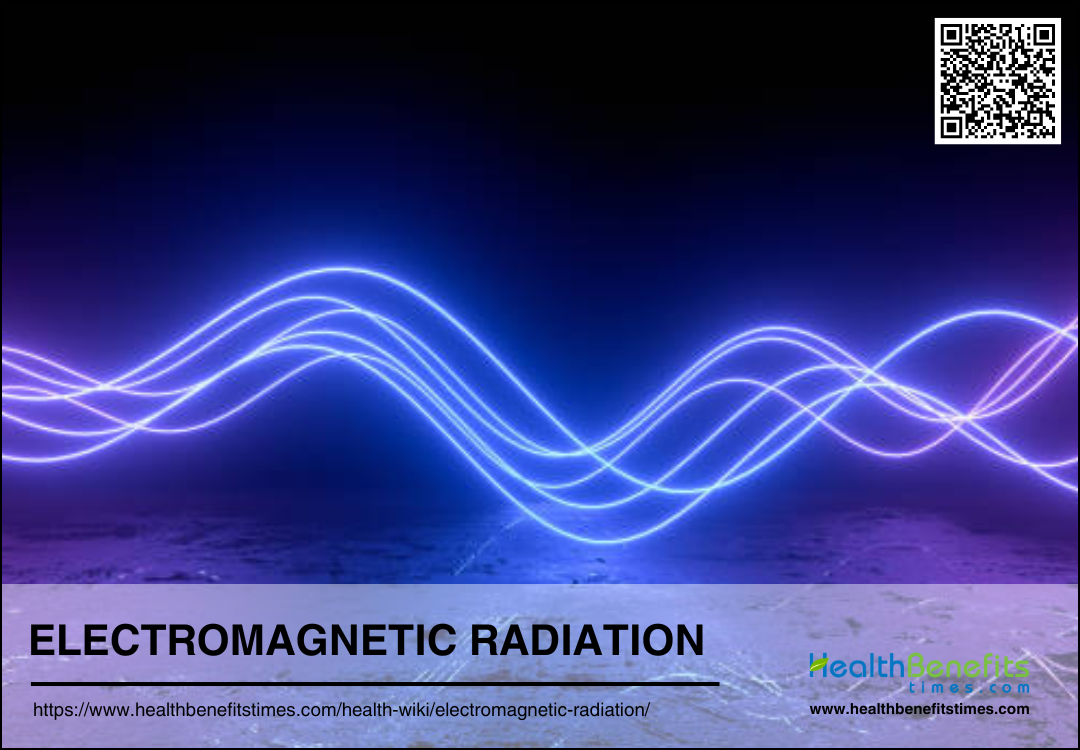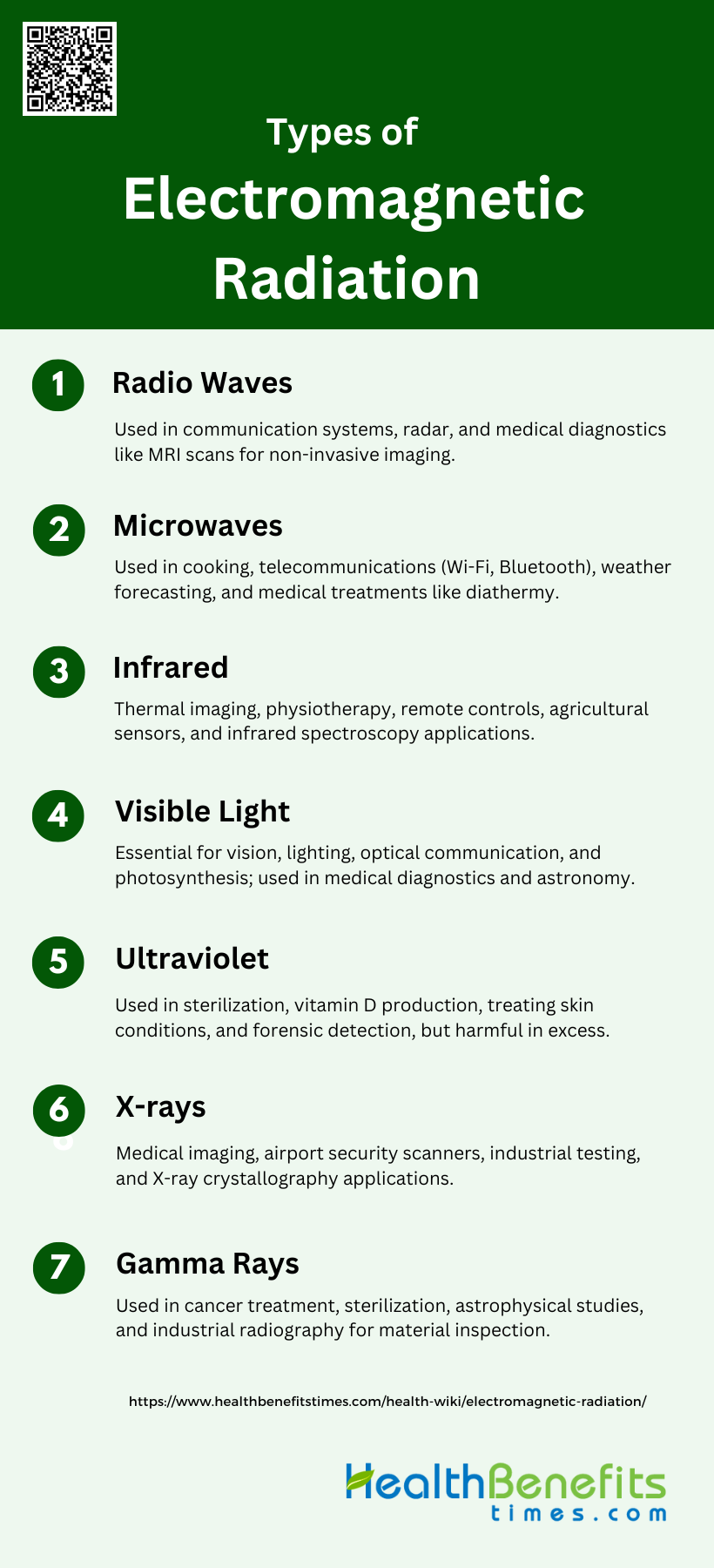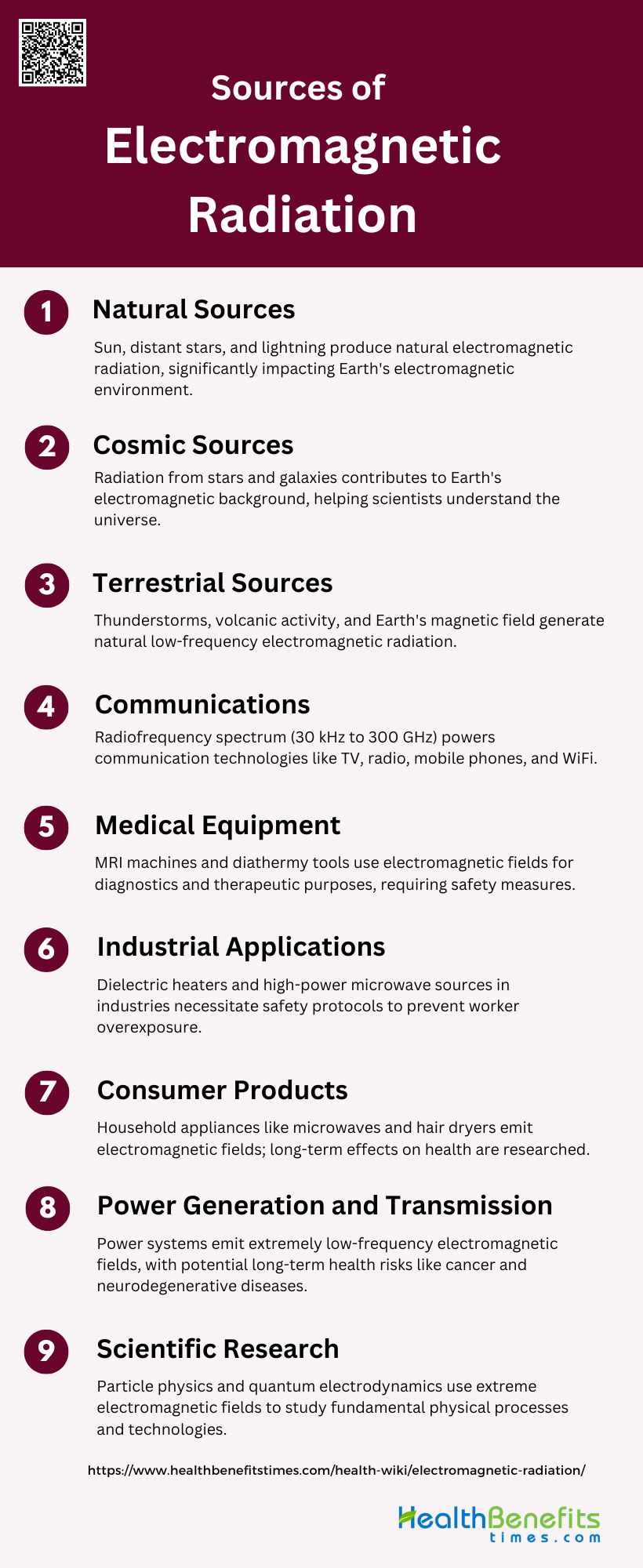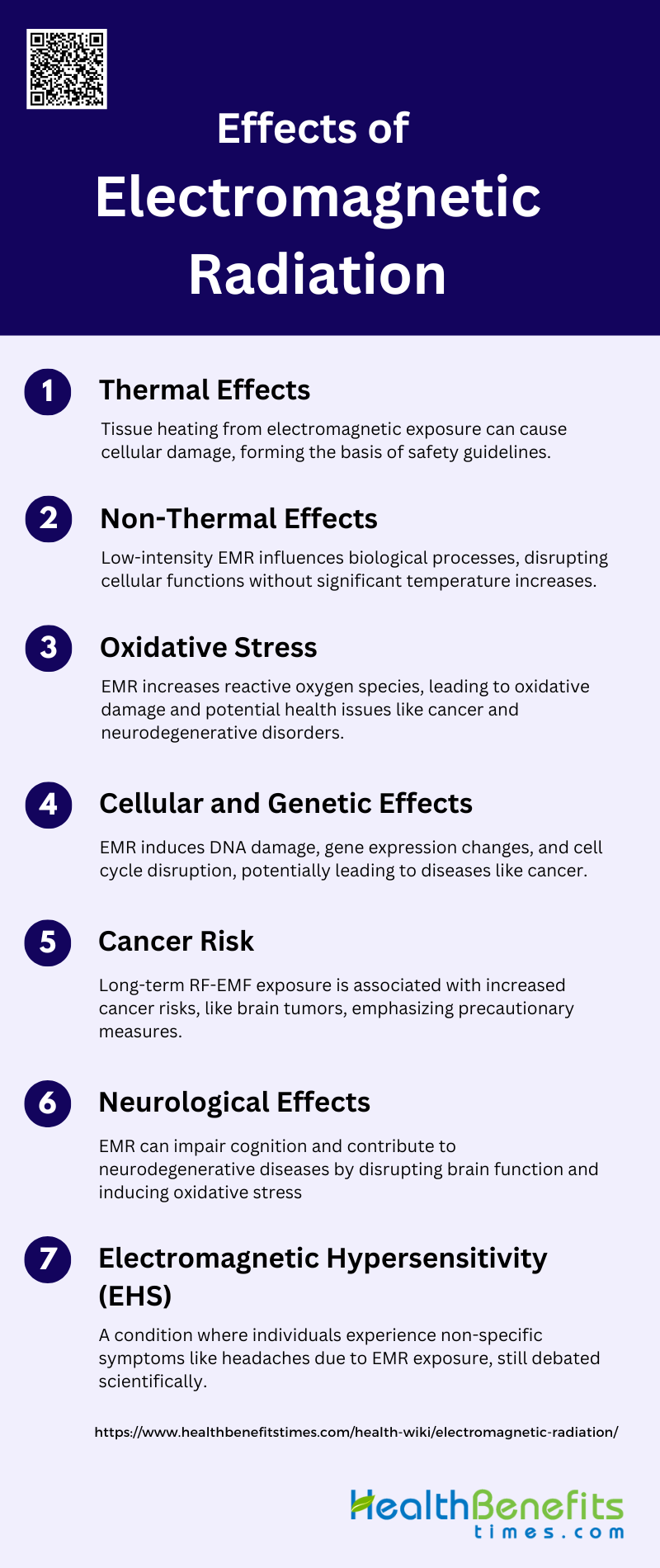Electromagnetic radiation is a form of energy that is released and absorbed by charged particles, exhibiting both electrical and magnetic properties. It encompasses a wide range of wavelengths, collectively known as the electromagnetic spectrum, which includes radio waves, microwaves, infrared, visible light, ultraviolet, X-rays, and gamma rays. This radiation can be described using two models: the wave model, which treats it as electromagnetic waves, and the particle model, which considers it as a flux of photons. The interaction of electromagnetic radiation with matter is fundamental to various applications, including telecommunications, medical imaging, and the analysis of physical and chemical properties of materials. Understanding the mechanisms behind electromagnetic radiation, such as the flip-flop of combined circular magnetic and electric fields, is crucial for advancing technologies and addressing potential health effects associated with exposure.
Types of Electromagnetic Radiation
The electromagnetic spectrum encompasses a range of radiation types, each with unique characteristics and applications. From the longest wavelengths of radio waves to the shortest wavelengths of gamma rays, these forms of radiation play crucial roles in various fields. Below is a detailed look at each type of electromagnetic radiation:
1. Radio Waves
Radio waves are characterized by their long wavelengths and low frequencies, making them ideal for communication technologies such as radio and television broadcasting, as well as mobile phone networks. They are essential for wireless communication systems, enabling the transmission of data over long distances without the need for physical connections.
2. Microwaves
Microwaves have shorter wavelengths than radio waves and are used in various applications, including radar systems, satellite communications, and microwave ovens. In everyday appliances, microwaves are used for cooking and heating food. Safety measures are important to prevent exposure to high levels of microwave radiation, which can cause thermal injuries.
3. Infrared Radiation
Infrared radiation is primarily used for thermal imaging and night-vision devices, allowing the detection of heat emitted by objects. It also plays a crucial role in remote controls for electronic devices and has applications in health, such as in physiotherapy and infrared saunas.
4. Visible Light
Visible light is the portion of the electromagnetic spectrum that can be detected by the human eye, enabling vision. It is used in various fields, including art, where it is essential for color perception, technology such as LED lighting and displays, and space exploration for imaging distant celestial objects.
5. Ultraviolet Radiation
Ultraviolet (UV) radiation has shorter wavelengths than visible light and can have both beneficial and harmful effects. It is used in health applications for sterilizing medical equipment and in industry for curing inks and coatings. However, excessive exposure to UV rays can cause skin damage and increase the risk of skin cancer.
6. X-rays
X-rays are a form of high-energy electromagnetic radiation used primarily in medical imaging to view the inside of the body. They are crucial for diagnosing fractures, infections, and tumors. Safety measures, such as lead aprons and limiting exposure, are essential to protect against the harmful effects of X-rays.
7. Gamma Rays
Gamma rays have the highest energy and shortest wavelengths in the electromagnetic spectrum. They are used in medicine for cancer treatment through radiation therapy and in astronomy to study high-energy phenomena in the universe. Due to their high energy, gamma rays require stringent safety measures to protect against their potentially harmful effects.
How Electromagnetic Radiation Travels
Explanation of how electromagnetic waves propagate through space
Electromagnetic waves propagate through space as oscillating electric and magnetic fields that are perpendicular to each other and to the direction of wave travel. These waves do not require a medium and can travel through a vacuum. The propagation is governed by Maxwell’s equations, which describe how electric and magnetic fields interact and change over time. In free space, the energy transport velocity of these waves is closely related to the group velocity, which can be either superluminal or subluminal under specific conditions, but the upper limit remains the speed of light, (c).
The speed of light and its importance in electromagnetic radiation
The speed of light in a vacuum, denoted as (c), is a fundamental constant with an exact value of 299,792,458 meters per second. This speed is crucial because it represents the maximum speed at which information and energy can travel. The speed of light is not just a measure of how fast light travels; it also sets the upper limit for the speed of electromagnetic wave propagation. This constant is essential for understanding the behavior of electromagnetic fields, especially in complex scenarios where the wavefront travels at (c), but other parts of the waveform may exhibit different dynamics, such as appearing to move inwards or back in time.
Interaction of electromagnetic radiation with different media (air, water, vacuum)
When electromagnetic radiation interacts with different media, its speed and behavior change depending on the medium’s properties. In a vacuum, electromagnetic waves travel at the speed of light, (c). However, in media like air or water, the speed is reduced due to the medium’s refractive index. For instance, when an electromagnetic wave crosses the boundary between two media, phenomena such as reflection, refraction, and transmission occur. The refractive index of the medium determines how much the wave slows down and bends. In dynamic optical media, where the refractive index changes with time, the speed of light can vary, leading to complex interactions such as impedance mismatch and temporal scaling.
Sources of Electromagnetic Radiation
Electromagnetic radiation originates from a variety of sources, both natural and artificial. These sources span from cosmic phenomena to everyday consumer products, each contributing uniquely to the electromagnetic spectrum. Below is a detailed overview of the sources of electromagnetic radiation:
1. Natural Sources
Natural sources of electromagnetic radiation include the sun, distant stars, and atmospheric discharges such as lightning. These sources contribute to the Earth’s natural electromagnetic background. For instance, solar radiation is a significant source of natural electromagnetic fields, impacting both the environment and biological systems. Additionally, the human body itself can emit low levels of electromagnetic fields. These natural sources have been present long before human-made sources and continue to play a crucial role in the Earth’s electromagnetic environment.
2. Cosmic Sources
Cosmic sources of electromagnetic radiation originate from outer space, including distant stars, galaxies, and cosmic microwave background radiation. These sources contribute to the natural electromagnetic background of the Earth. Cosmic radiation encompasses a wide range of frequencies, from radio waves to gamma rays, and can influence both terrestrial and extraterrestrial environments. The study of cosmic electromagnetic radiation helps scientists understand the universe’s structure and the fundamental processes occurring in space.
3. Terrestrial Sources
Terrestrial sources of electromagnetic radiation include natural phenomena such as thunderstorms and volcanic activity, which produce electromagnetic fields. Additionally, the Earth’s magnetic field itself is a source of low-frequency electromagnetic radiation. These sources are part of the natural electromagnetic environment and can influence various biological and ecological processes. Understanding terrestrial sources is essential for studying the Earth’s electromagnetic field and its interactions with living organisms.
4. Communications
Electromagnetic radiation is extensively used in communication technologies, including radio, television, mobile phones, and WiFi. These technologies operate within the radiofrequency (RF) spectrum, ranging from 30 kHz to 300 GHz. Communication devices emit electromagnetic fields that facilitate the transmission of voice, data, and multimedia content. The widespread use of these devices has raised concerns about potential health effects due to prolonged exposure to RF radiation, necessitating ongoing research and regulation.
5. Medical Equipment
Medical equipment such as MRI machines, diathermy devices, and electrocautery tools utilize electromagnetic fields for diagnostic and therapeutic purposes. These devices operate at various frequencies, from extremely low frequencies (ELFs) to radiofrequencies (RFs). While they offer significant medical benefits, there is also a need to monitor and regulate exposure levels to prevent potential adverse health effects. The therapeutic use of electromagnetic fields in medicine continues to evolve, with ongoing research into their safety and efficacy.
6. Industrial Applications
Industrial applications of electromagnetic radiation include the use of dielectric heaters, induction heaters, and high-power microwave sources. These technologies are employed in processes such as plastic sealing, wood lamination, and material processing. Industrial electromagnetic sources can emit high levels of radiation, necessitating safety measures to protect workers from overexposure. The development of pulsed power technology has further expanded the use of high-power microwave sources in various industrial applications.
7. Consumer Products
Many consumer products emit electromagnetic radiation, including household appliances like microwaves, hair dryers, and televisions. These devices operate at different frequencies and power levels, contributing to the electromagnetic environment in homes. While generally considered safe, there is ongoing research into the potential health effects of long-term exposure to low-level electromagnetic fields from consumer products. Regulatory standards help ensure that these products do not pose significant health risks.
8. Power Generation and Transmission
Power generation and transmission systems are significant sources of electromagnetic fields, particularly at extremely low frequencies (ELFs). High-voltage transmission lines, transformers, and in-house wiring emit electromagnetic fields that can extend into surrounding areas. There is ongoing research into the potential health effects of long-term exposure to these fields, with some studies suggesting an increased risk of certain cancers and neurodegenerative diseases. Mitigation measures and regulatory standards aim to minimize exposure and ensure public safety.
9. Scientific Research
Scientific research utilizes electromagnetic radiation in various fields, including particle physics, plasma physics, and quantum electrodynamics (QED). High-power lasers and other advanced technologies create and study extreme electromagnetic fields, enabling researchers to explore fundamental physical processes and develop new applications. These research activities contribute to our understanding of electromagnetic phenomena and their potential uses in technology and medicine. The development of nonradiating sources and high-power microwave sources are examples of ongoing advancements in this area.
Effects of Electromagnetic Radiation
Electromagnetic radiation can have various effects on biological systems, ranging from thermal to non-thermal impacts. These effects can influence cellular functions, genetic material, and overall health. Below is a detailed examination of the primary effects of electromagnetic radiation.
1. Thermal Effects
Thermal effects of electromagnetic radiation (EMR) are primarily associated with the heating of tissues due to the absorption of energy. This phenomenon is well-documented and forms the basis for many safety standards. For instance, exposure to radiofrequency electromagnetic fields (RF-EMF) can lead to an increase in tissue temperature, which can cause cellular damage if the exposure is prolonged or intense. The current safety guidelines are largely based on these thermal effects, aiming to prevent significant temperature rises in human tissues. However, these guidelines may not fully account for the non-thermal effects that are increasingly being recognized as significant health risks.
2. Non-Thermal Effects
Non-thermal effects of EMR are those that occur without a significant increase in temperature. These effects can influence various biological processes, including cellular signaling, gene expression, and membrane function. Studies have shown that even low-intensity EMR can cause significant biological changes, such as alterations in calcium signaling and the activation of free radical processes. These non-thermal effects can disrupt normal cellular functions and have been linked to various health issues, including reproductive problems, neurobehavioral changes, and even cancer.
3. Oxidative Stress
Oxidative stress is a critical mechanism through which EMR exerts its biological effects. Exposure to EMR has been shown to increase the production of reactive oxygen species (ROS), leading to oxidative damage in cells and tissues. This oxidative stress can result in DNA damage, lipid peroxidation, and protein oxidation, contributing to various diseases, including cancer and neurodegenerative disorders. Studies have demonstrated that both extremely low-frequency (ELF) and RF-EMF can induce oxidative stress, highlighting the need for further research to understand the long-term health implications.
4. Cellular and Genetic Effects
EMR can cause significant cellular and genetic effects, including DNA damage, gene expression alterations, and disruptions in cell cycle regulation. These effects are part of the cellular stress response, a mechanism that aims to repair and restore cellular homeostasis. However, prolonged or intense exposure can overwhelm these repair mechanisms, leading to cell death or malignant transformation. Studies have shown that EMR can induce both epigenetic and genetic changes, which may contribute to the development of various diseases, including cancer.
5. Cancer Risk
The potential carcinogenic effects of EMR have been a major concern, leading to its classification as “possibly carcinogenic to humans” by the International Agency for Research on Cancer (IARC). Long-term exposure to RF-EMF, such as from mobile phones, has been associated with an increased risk of brain tumors and other cancers. The mechanisms involved include oxidative stress, DNA damage, and alterations in gene expression. While the evidence is still evolving, these findings underscore the need for precautionary measures and further research to fully understand the cancer risks associated with EMR exposure.
FAQS
1. What is the difference between ionizing and non-ionizing radiation?
Ionizing radiation has enough energy to remove tightly bound electrons from atoms, which can cause chemical changes in materials, including living tissue. Examples include X-rays and gamma rays. Non-ionizing radiation, such as radio waves, microwaves, and visible light, has lower energy and cannot ionize atoms. However, non-ionizing radiation can still have biological effects, such as heating tissues.
2. How is electromagnetic radiation different from mechanical waves like sound?
Electromagnetic radiation does not require a medium to travel through, meaning it can propagate in a vacuum, unlike mechanical waves like sound, which need a medium like air or water to move. Electromagnetic waves travel at the speed of light, whereas sound waves travel much more slowly.
3. Can electromagnetic radiation be harmful to human health?
Prolonged exposure to certain types of electromagnetic radiation, especially ionizing radiation like X-rays and gamma rays, can be harmful and increase the risk of cancer and tissue damage. Non-ionizing radiation from sources such as mobile phones and microwaves is generally considered less harmful but still subject to safety regulations.
4. Why do electromagnetic waves not need a medium to travel?
Electromagnetic waves consist of oscillating electric and magnetic fields that can propagate through the vacuum of space. These fields do not rely on molecules or particles to carry them, unlike sound waves, which need a physical medium to propagate.
5. How do electromagnetic waves carry energy?
Electromagnetic waves carry energy in the form of photons, which can be thought of as packets of energy. The energy of a photon is proportional to its frequency: higher-frequency radiation (like gamma rays) carries more energy, while lower-frequency radiation (like radio waves) carries less.
6. How is electromagnetic radiation used in modern communications technology?
Electromagnetic radiation is fundamental to modern communication systems. Radio waves, microwaves, and infrared radiation are used in mobile phones, Wi-Fi networks, satellite communications, and television broadcasting, enabling wireless transmission of data over large distances.
7. What is the role of electromagnetic radiation in photosynthesis?
In photosynthesis, plants use electromagnetic radiation, specifically visible light, to convert carbon dioxide and water into glucose and oxygen. This process powers most life on Earth, making sunlight a critical source of energy for ecosystems.
8. Why is electromagnetic radiation important in medical imaging?
Medical imaging techniques, such as X-rays and MRI, rely on different types of electromagnetic radiation to produce detailed images of the body’s internal structures. These techniques allow doctors to diagnose conditions without invasive procedures.
9. How does electromagnetic radiation contribute to global climate change?
Electromagnetic radiation from the sun, in the form of ultraviolet, visible, and infrared light, warms the Earth’s surface. Greenhouse gases trap some of this radiation, preventing it from escaping back into space, which contributes to the warming of the planet and global climate change.
10. What are some common safety precautions for handling electromagnetic radiation?
To minimize risks associated with exposure to electromagnetic radiation, people often use lead aprons during X-rays, follow guidelines for limiting mobile phone usage, maintain proper shielding for high-energy radiation sources, and ensure proper microwave sealing to prevent leakage.





